Numerical Study of Crack Prediction and Growth in Automotive Wheel Rims
Abstract
:1. Introduction
2. Theoretical Background
2.1. Coupled Volumetric Method with XFEM
2.2. XFEM Setup
3. Overview of Experimental Data
3.1. Fatigue Test
3.2. Material Properties
4. Numerical Analysis, Results and Discussion
4.1. XFEM Model
4.2. Boundary Conditions
4.3. Mesh Detail
4.4. Model Calibration
4.5. Fatigue Analysis
4.6. Comparison between the Proposed Method and Experimental Method
4.7. Stress Intensity Factor
5. Discussions
6. Conclusions
Author Contributions
Funding
Institutional Review Board Statement
Informed Consent Statement
Data Availability Statement
Conflicts of Interest
References
- Lu, P.; Zhang, Y.K.; Ma, F. Finite Element Analysis on Multi-Step Rolling Process and Controlling Quality Defect for Steel Wheel Rim. Adv. Mech. Eng. 2015, 7, 1687814015596115. [Google Scholar] [CrossRef]
- Dey, A.; Jugade, H.; Jain, V.; Adhikary, M. Cracking Phenomena in Automotive Wheels: An Insight. Eng. Fail. Anal. 2019, 105, 1273–1286. [Google Scholar] [CrossRef]
- Belodedenko, S.; Hrechanyi, O.; Vasilchenko, T.; Baiul, K.; Hrechana, A. Development of a Methodology for Mechanical Testing of Steel Samples for Predicting the Durability of Vehicle Wheel Rims. Results Eng. 2023, 18, 101117. [Google Scholar] [CrossRef]
- He, X.; Kuang, S.; Zhao, G.; Shan, Q.; Chen, T.; Ma, T.; Zhang, Z.; Guo, L. Fatigue Failure Analysis and Microstructural Characterizations on Flash Butt Welded Joint of Automotive Steel Wheel Rim. J. Mater. Eng. Perform. 2023, 1–10. [Google Scholar] [CrossRef]
- Seifi, R.; Asadi, M. Study of Stress Intensity Factors in Sliding and Tearing Modes for Subsurface Elliptical Cracks in Rolling Train Wheels. Fatigue Fract. Eng. Mater. Struct. 2023, 46, 2568–2584. [Google Scholar] [CrossRef]
- Zanchini, M.; Longhi, D.; Mantovani, S.; Puglisi, F.; Giacalone, M. Fatigue and Failure Analysis of Aluminium and Composite Automotive Wheel Rims: Experimental and Numerical Investigation. Eng. Fail. Anal. 2023, 146, 107064. [Google Scholar] [CrossRef]
- Nejad, R.M.; Berto, F. Fatigue Fracture and Fatigue Life Assessment of Railway Wheel Using Non-linear Model for Fatigue Crack Growth. Int. J. Fatigue 2021, 153, 106516. [Google Scholar] [CrossRef]
- Nejad, R.M.; Berto, F. Fatigue Crack Growth of a Railway Wheel Steel and Fatigue Life Prediction under Spectrum Loading Conditions. Int. J. Fatigue 2022, 157, 106722. [Google Scholar] [CrossRef]
- Fang, X.-Y.; Zhao, Y.-X.; Liu, H.-W. Study on Fatigue Failure Mechanism at Various Temperatures of a High-Speed Railway Wheel Steel. Mater. Sci. Eng. A 2017, 696, 299–314. [Google Scholar] [CrossRef]
- Nejad, R.M.; Farhangdoost, K.; Shariati, M. Numerical Study on Fatigue Crack Growth in Railway Wheels under the Influence of Residual Stresses. Eng. Fail. Anal. 2015, 52, 75–89. [Google Scholar] [CrossRef]
- Topaç, M.; Ercan, S.; Kuralay, N. Fatigue Life Prediction of a Heavy Vehicle Steel Wheel under Radial Loads by Using Finite Element Analysis. Eng. Fail. Anal. 2012, 20, 67–79. [Google Scholar] [CrossRef]
- Kuna, M. Finite Elements in Fracture Mechanics. Solid Mech. Its Appl. 2013, 201, 153–192. [Google Scholar]
- Réthoré, J.; Gravouil, A.; Combescure, A. A Stable Numerical Scheme for the Finite Element Simulation of Dynamic Crack Propagation with Remeshing. Comput. Methods Appl. Mech. Eng. 2004, 193, 4493–4510. [Google Scholar] [CrossRef]
- Jan, Y. Modélisation de La Propagation de Fissure Sur Des Structures Minces, Soumises à Des Sollicitations Intenses et Rapides, Par La Méthode X-FEM; Université de Lyon: Lyon, France, 2016. [Google Scholar]
- Terzano, M.; Dini, D.; Rodriguez y Baena, F.; Spagnoli, A.; Oldfield, M. An Adaptive Finite Element Model for Steerable Needles. Biomech. Model. Mechanobiol. 2020, 19, 1809–1825. [Google Scholar] [CrossRef] [PubMed]
- Moës, N.; Dolbow, J.; Belytschko, T. A Finite Element Method for Crack Growth without Remeshing. Int. J. Numer. Methods Eng. 1999, 46, 131–150. [Google Scholar] [CrossRef]
- Ameli, I.; Asgarian, B.; Lin, M.; Agbo, S.; Cheng, R.; Duan, D.; Adeeb, S. Estimation of the CTOD-Crack Growth Curves in SENT Specimens Using the eXtended Finite Element Method. Int. J. Press. Vessel. Pip. 2019, 169, 16–25. [Google Scholar] [CrossRef]
- Shahzamanian, M.M.; Kainat, M.; Yoosef-Ghodsi, N.; Adeeb, S. Systematic Literature Review of the Application of Extended Finite Element Method in Failure Prediction of Pipelines. J. Pipeline Sci. Eng. 2021, 1, 241–251. [Google Scholar] [CrossRef]
- Ghoneim, A. A Meshfree Interface-Finite Element Method for Modelling Isothermal Solutal Melting and Solidification in Binary Systems. Finite Elem. Anal. Des. 2015, 95, 20–41. [Google Scholar] [CrossRef]
- Melenk, J.M.; Babuška, I. The Partition of Unity Finite Element Method: Basic Theory and Applications. Comput. Methods Appl. Mech. Eng. 1996, 139, 289–314. [Google Scholar] [CrossRef]
- Strouboulis, T.; Babuška, I.; Copps, K. The Design and Analysis of the Generalized Finite Element Method. Comput. Methods Appl. Mech. Eng. 2000, 181, 43–69. [Google Scholar] [CrossRef]
- Koubaiti, O.; El-mekkaoui, J.; Elkhalfi, A. Complete Study for Solving Navier-Lamé Equation with New Boundary Condition Using Mini Element Method. Int. J. Mech. 2018, 12, 46–58. [Google Scholar]
- Montassir, S.; Yakoubi, K.; Moustabchir, H.; Elkhalfi, A.; Rajak, D.K.; Pruncu, C.I. Analysis of Crack Behaviour in Pipeline System Using FAD Diagram Based on Numerical Simulation under XFEM. Appl. Sci. 2020, 10, 6129. [Google Scholar] [CrossRef]
- Montassir, S.; Moustabchir, H.; Elkhalfi, A.; Scutaru, M.L.; Vlase, S. Fracture Modelling of a Cracked Pressurized Cylindrical Structure by Using Extended Iso-Geometric Analysis (X-IGA). Mathematics 2021, 9, 2990. [Google Scholar] [CrossRef]
- Yakoubi, K.; Montassir, S.; Moustabchir, H.; Elkhalfi, A.; Pruncu, C.I.; Arbaoui, J.; Farooq, M.U. An Extended Finite Element Method (XFEM) Study on the Elastic T-Stress Evaluations for a Notch in a Pipe Steel Exposed to Internal Pressure. Mathematics 2021, 9, 507. [Google Scholar] [CrossRef]
- Pluvinage, G. Fracture and Fatigue Emanating from Stress Concentrators; Springer Science & Business Media: Berlin/Heidelberg, Germany, 2007; ISBN 1-4020-2612-9. [Google Scholar]
- Moustabchir, H.; Zitouni, A.; Hariri, S.; Gilgert, J.; Pruncu, C. Experimental–Numerical Characterization of the Fracture Behaviour of P264GH Steel Notched Pipes Subject to Internal Pressure. Iran. J. Sci. Technol. Trans. Mech. Eng. 2018, 42, 107–115. [Google Scholar] [CrossRef]
- Liao, D.; Zhu, S.; Correia, J.A.; De Jesus, A.M.; Berto, F. Recent Advances on Notch Effects in Metal Fatigue: A Review. Fatigue Fract. Eng. Mater. Struct. 2020, 43, 637–659. [Google Scholar] [CrossRef]
- Lin, M.; Agbo, S.; Duan, D.-M.; Cheng, J.R.; Adeeb, S. Simulation of Crack Propagation in API 5L X52 Pressurized Pipes Using XFEM-Based Cohesive Segment Approach. J. Pipeline Syst. Eng. Pract. 2020, 11, 4020009. [Google Scholar] [CrossRef]
- El Fakkoussi, S.; Vlase, S.; Marin, M.; Koubaiti, O.; Elkhalfi, A.; Moustabchir, H. Predicting Stress Intensity Factor for Aluminum 6062 T6 Material in L-Shaped Lower Control Arm (LCA) Design Using Extended Finite Element Analysis. Materials 2023, 17, 206. [Google Scholar] [CrossRef]
- Turteltaub, S.; van Hoorn, N.; Westbroek, W.; Hirsch, C. Multiscale Analysis of Mixed-Mode Fracture and Effective Traction-Separation Relations for Composite Materials. J. Mech. Phys. Solids 2018, 117, 88–109. [Google Scholar] [CrossRef]
- Reinhardt, L.; Cordes, J.; Geissler, D. Using Co-Simulation to Extend the Usage of XFEM. In Proceedings of the SIMULIA Customer Conference, Barcelona, Spain, 17–19 May 2011. [Google Scholar]
- Zheng, Z.; Yuan, S.; Sun, T.; Pan, S. Fractographic Study of Fatigue Cracks in a Steel Car Wheel. Eng. Fail. Anal. 2015, 47, 199–207. [Google Scholar] [CrossRef]
- Firat, M.; Kozan, R.; Ozsoy, M.; Mete, O.H. Numerical Modeling and Simulation of Wheel Radial Fatigue Tests. Eng. Fail. Anal. 2009, 16, 1533–1541. [Google Scholar] [CrossRef]
- Bansal, M.; Sarkar, S.; Singh, I.V. An XFEM-strain Gradient Damage Model for Efficient Modeling of Materials with Reinforcement Particles. Eng. Fract. Mech. 2022, 271, 108667. [Google Scholar] [CrossRef]
- Agbo, S.; Lin, M.; Ameli, I.; Imanpour, A.; Duan, D.-M.; Cheng, J.R.; Adeeb, S. Evaluation of the Effect of Internal Pressure and Flaw Size on the Tensile Strain Capacity of X42 Vintage Pipeline Using Damage Plasticity Model in Extended Finite Element Method (XFEM). Am. Soc. Mech. Eng. 2019, 58967, V005T05A006. [Google Scholar]
- Bozkurt, F.; Schmidová, E. Fracture Toughness Evaluation of S355 Steel Using Circumferentially Notched Round Bars. Period. Polytech. Transp. Eng. 2019, 47, 91–95. [Google Scholar] [CrossRef]
- Topaç, M.; Günal, H.; Kuralay, N. Fatigue Failure Prediction of a Rear Axle Housing Prototype by Using Finite Element Analysis. Eng. Fail. Anal. 2009, 16, 1474–1482. [Google Scholar] [CrossRef]
- Dassault Systèmes Simulia Corp. SIMULIA Fe-Safe. User Guide; Dassault Systemes: Vélizy-Villacoublay, France, 2019. [Google Scholar]
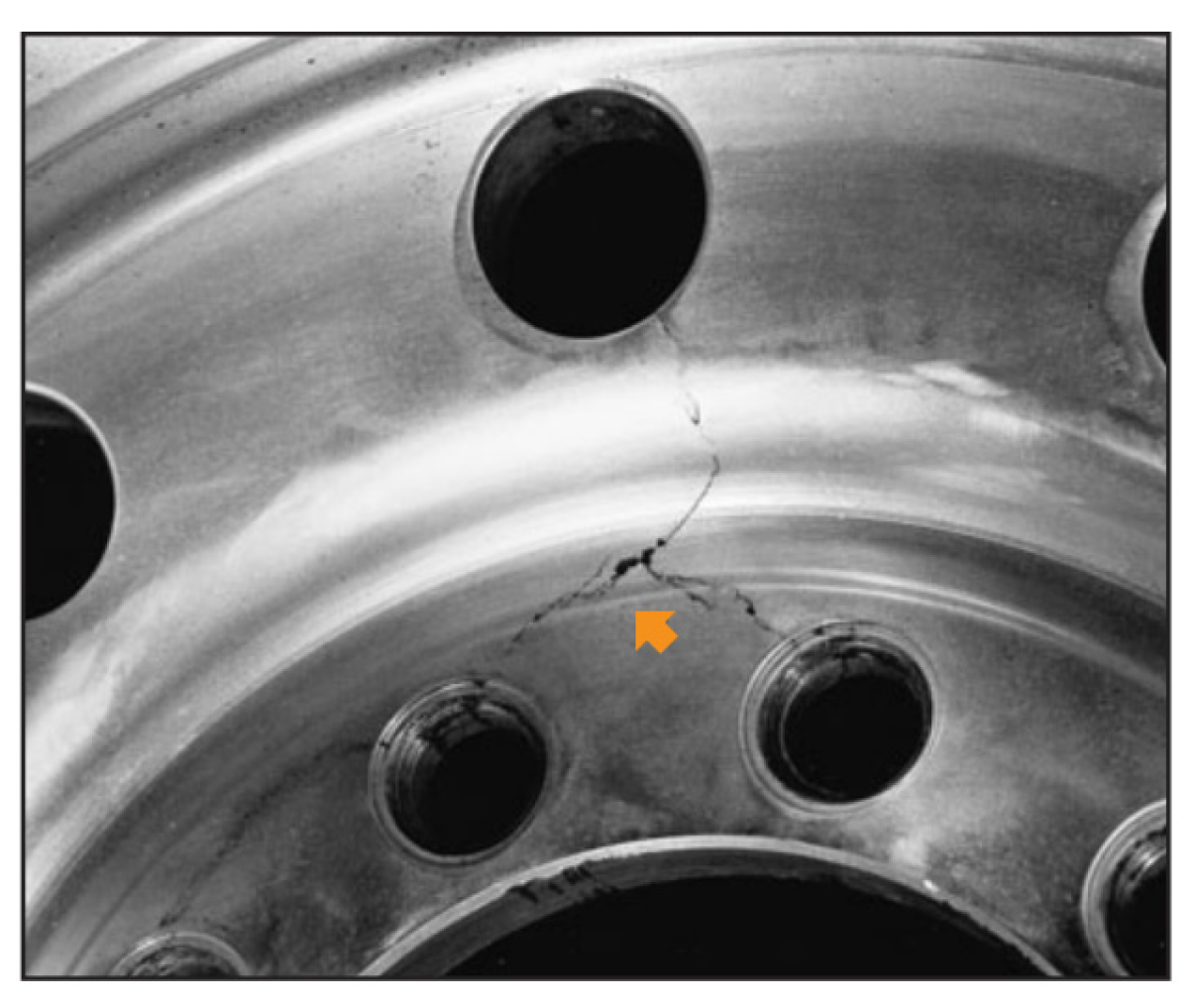

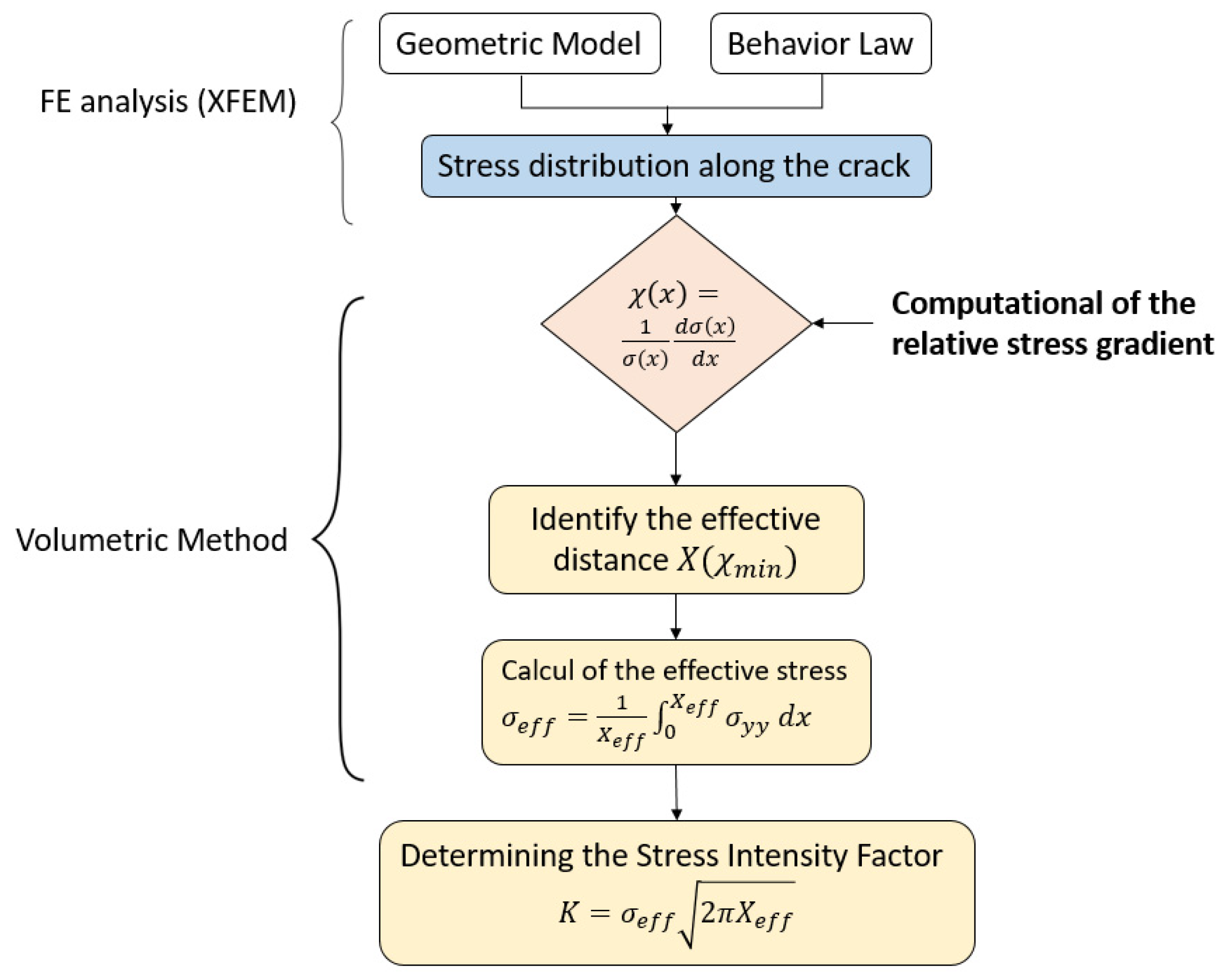


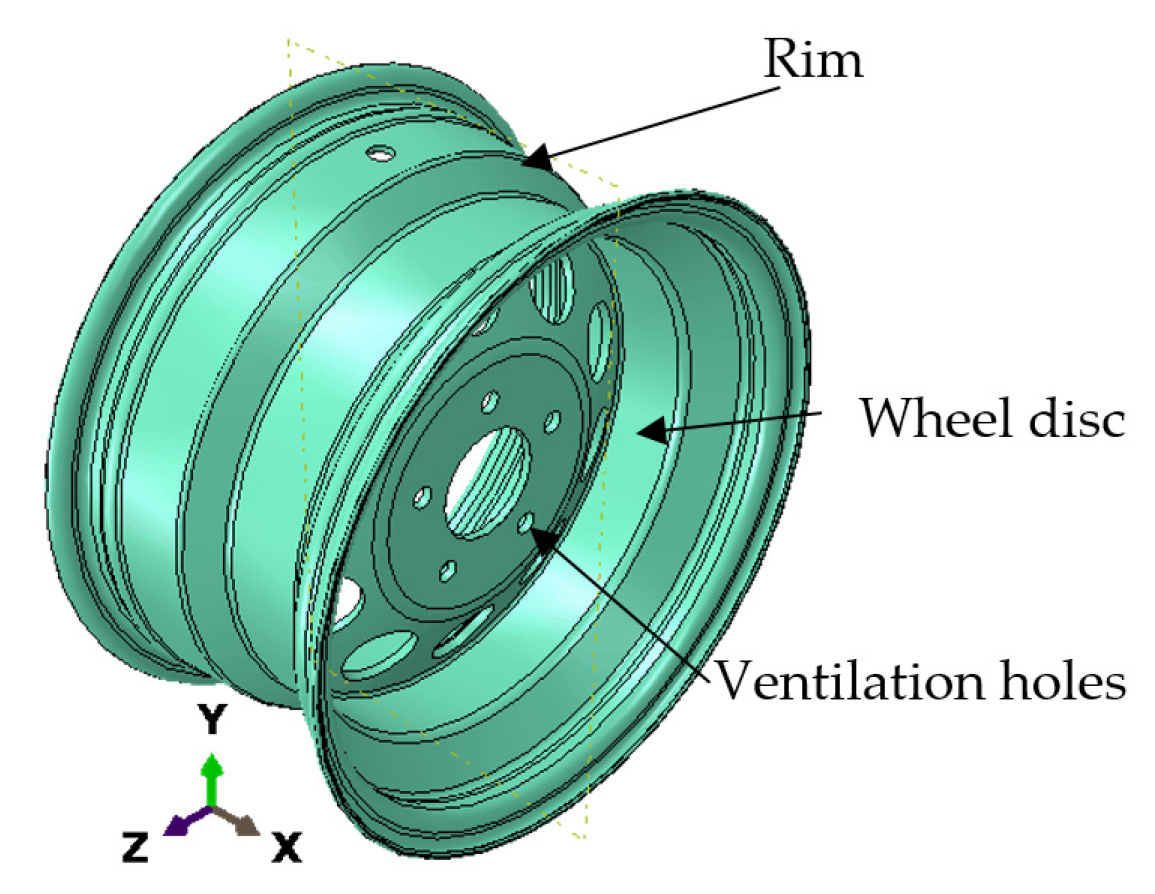
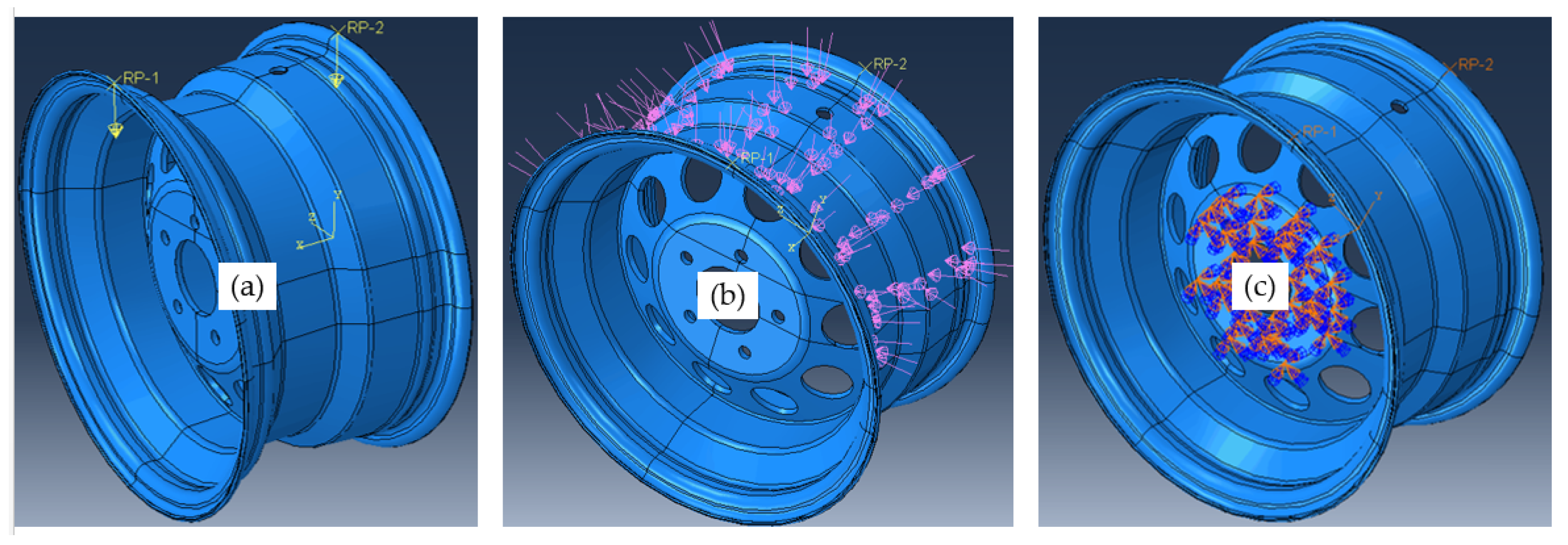
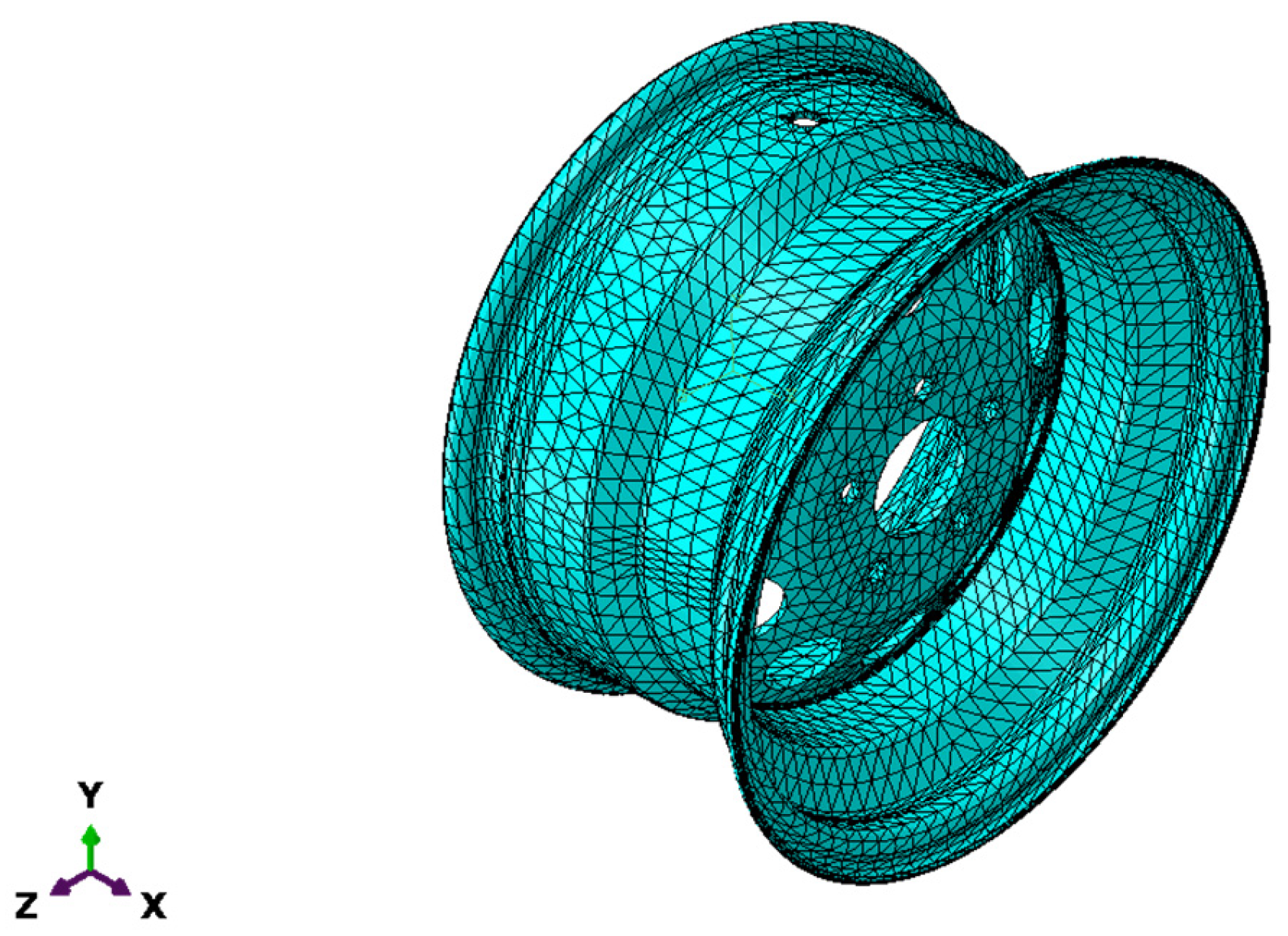
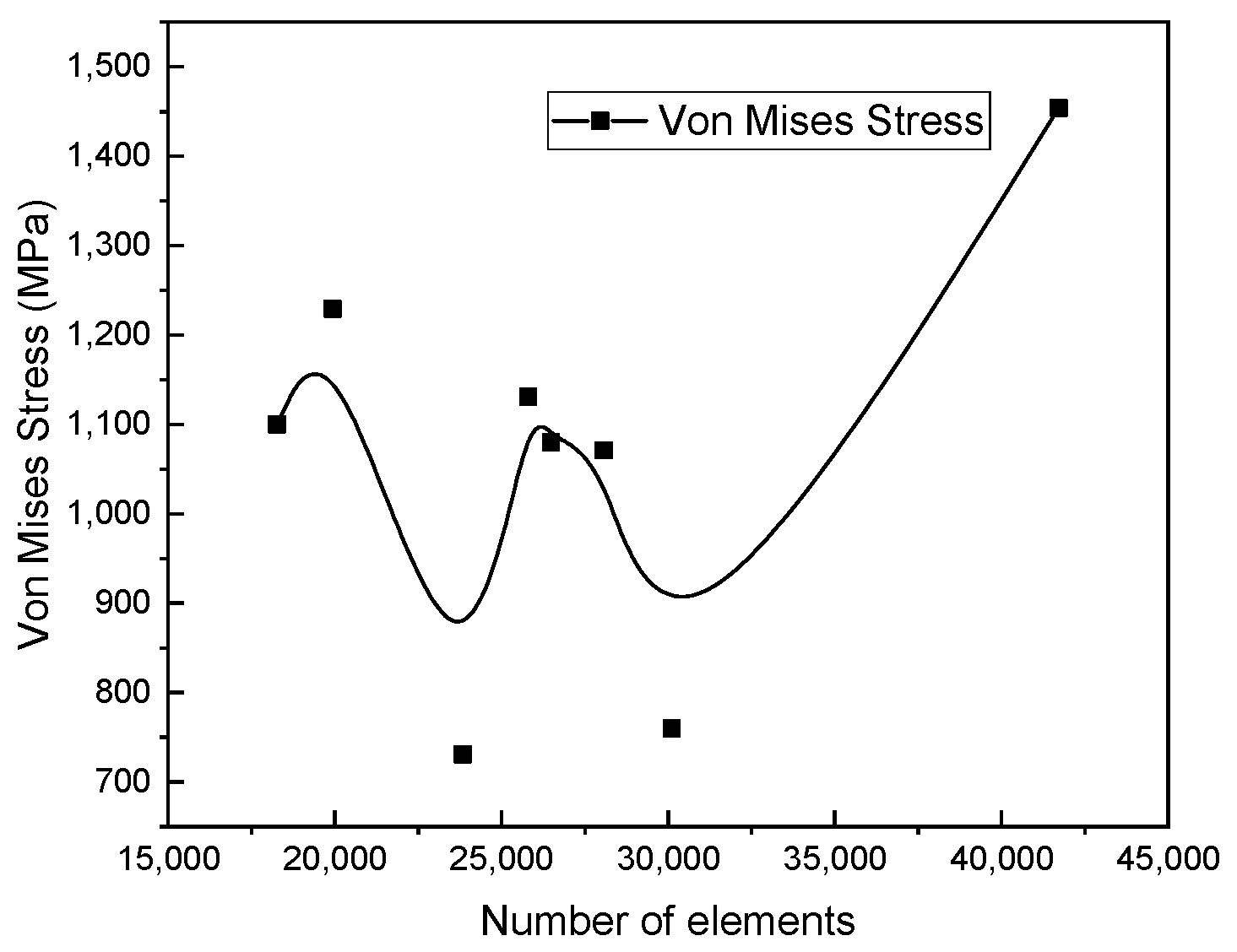
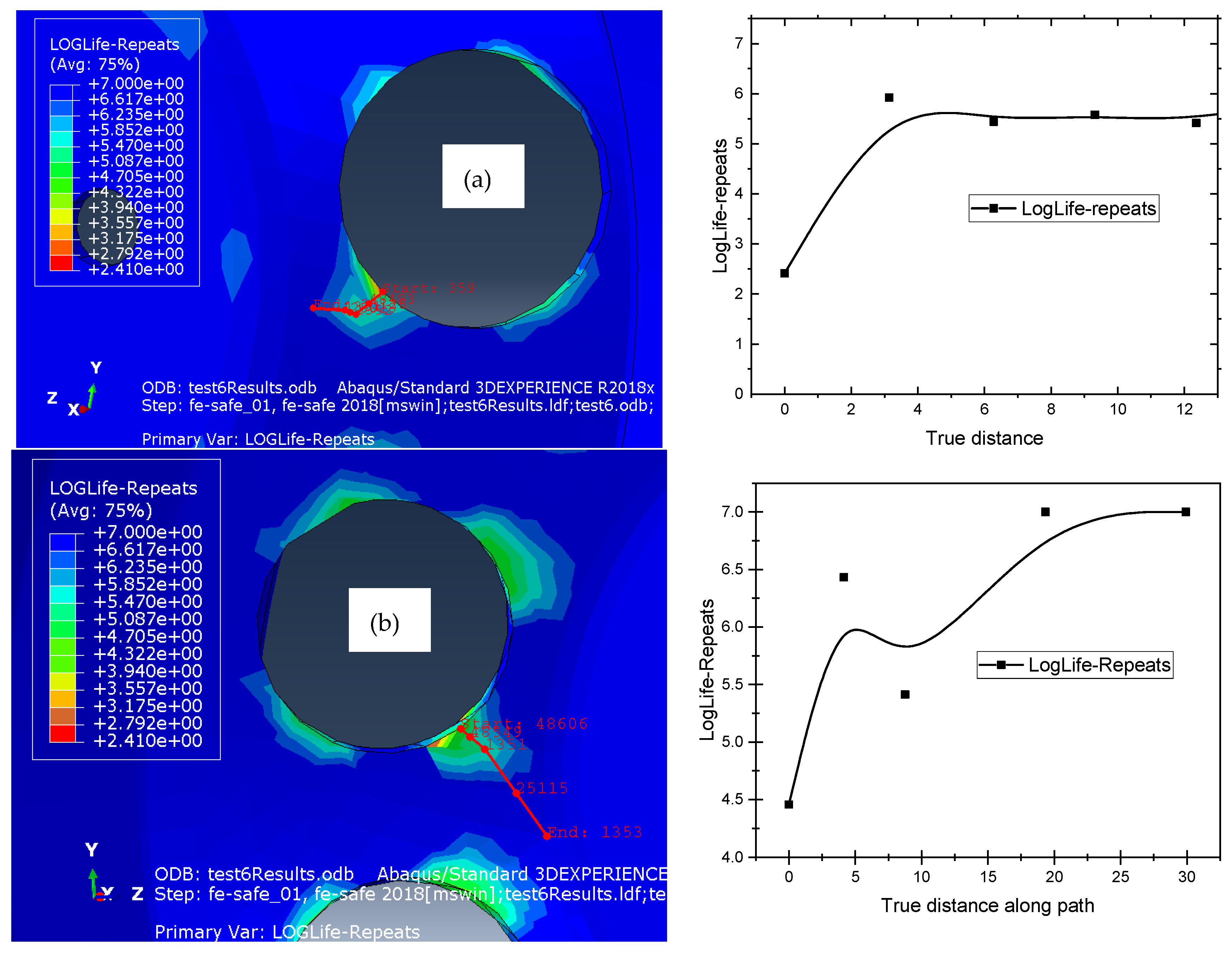
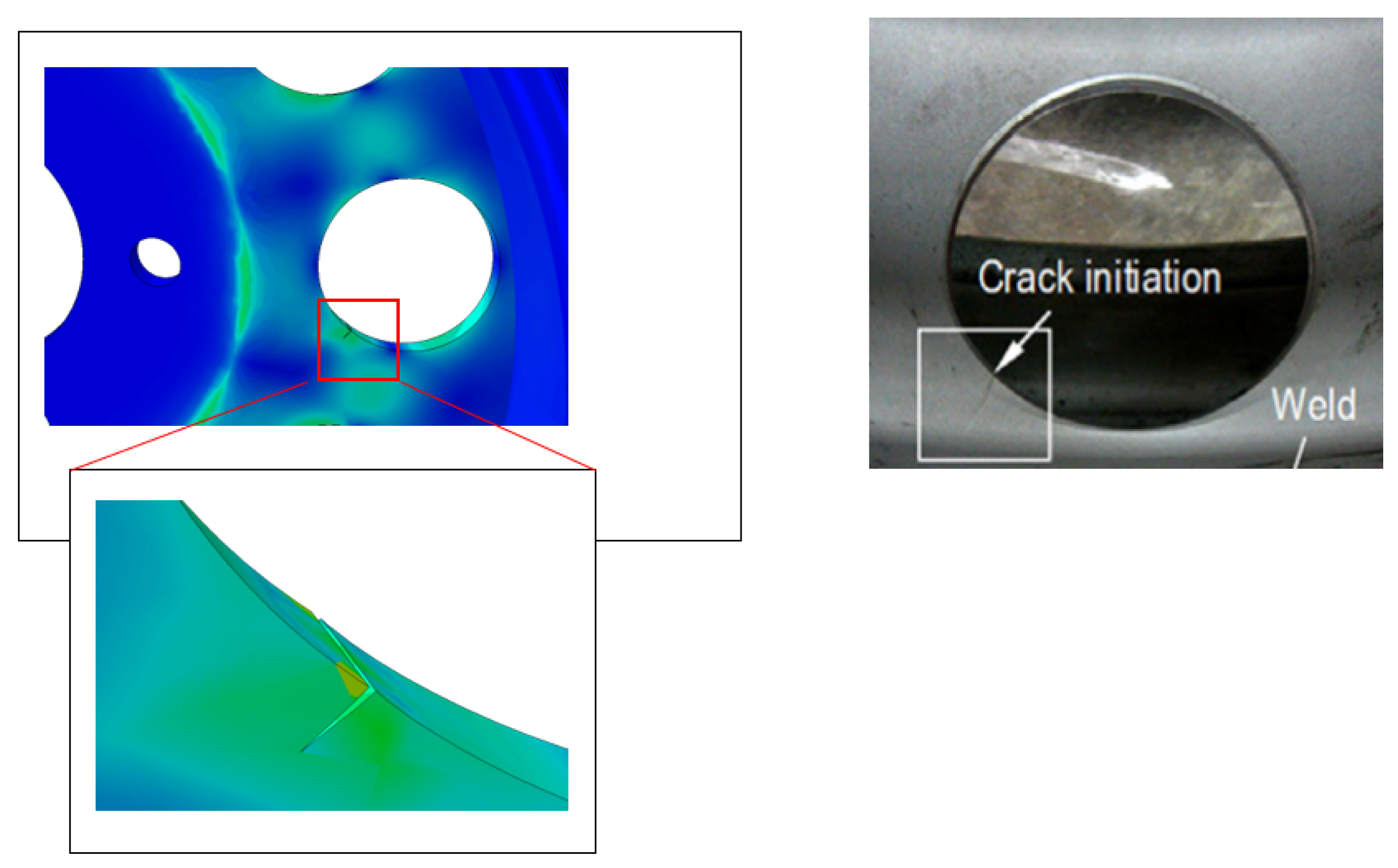
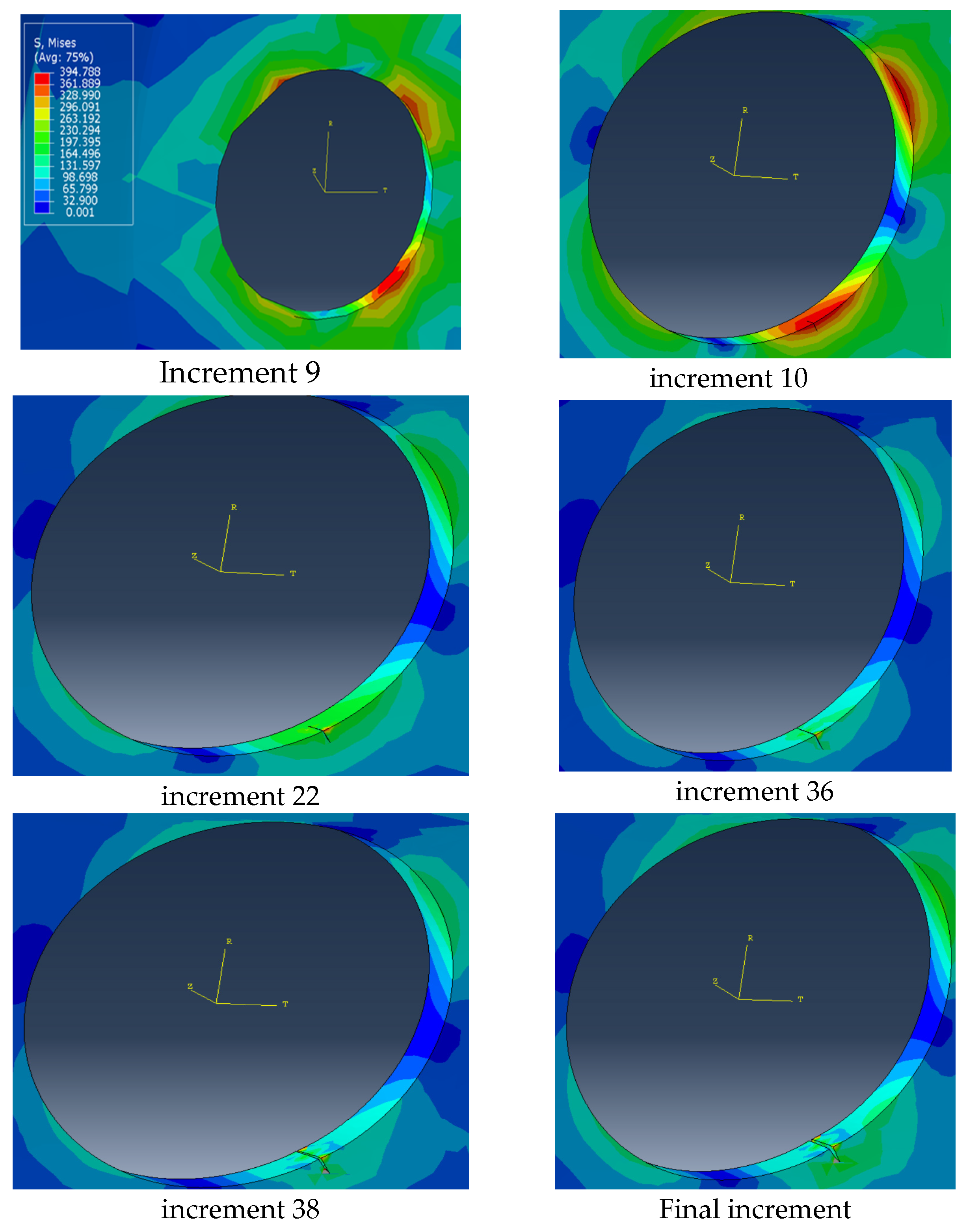

| Young’s modulus [GPa] | 210 |
| Poisson’s ratio | 0.3 |
| Yield stress [MPa] | 374.51 |
| Ultime stress [MPa] | 522.57 |
| Maximum Elongation [%] | 24.75 |
| Rim Diameter | 381 mm |
| Rim Width | 203.2 mm |
| Backspace | 76.2 |
| Number of bolts/stud holes | 6 × 139.7 and 5 × 114.3 |
Disclaimer/Publisher’s Note: The statements, opinions and data contained in all publications are solely those of the individual author(s) and contributor(s) and not of MDPI and/or the editor(s). MDPI and/or the editor(s) disclaim responsibility for any injury to people or property resulting from any ideas, methods, instructions or products referred to in the content. |
© 2024 by the authors. Licensee MDPI, Basel, Switzerland. This article is an open access article distributed under the terms and conditions of the Creative Commons Attribution (CC BY) license (https://creativecommons.org/licenses/by/4.0/).
Share and Cite
Montassir, S.; Moustabchir, H.; El Khalfi, A.; Vlase, S.; Scutaru, M.L. Numerical Study of Crack Prediction and Growth in Automotive Wheel Rims. Materials 2024, 17, 1020. https://doi.org/10.3390/ma17051020
Montassir S, Moustabchir H, El Khalfi A, Vlase S, Scutaru ML. Numerical Study of Crack Prediction and Growth in Automotive Wheel Rims. Materials. 2024; 17(5):1020. https://doi.org/10.3390/ma17051020
Chicago/Turabian StyleMontassir, Soufiane, Hassane Moustabchir, Ahmed El Khalfi, Sorin Vlase, and Maria Luminita Scutaru. 2024. "Numerical Study of Crack Prediction and Growth in Automotive Wheel Rims" Materials 17, no. 5: 1020. https://doi.org/10.3390/ma17051020









